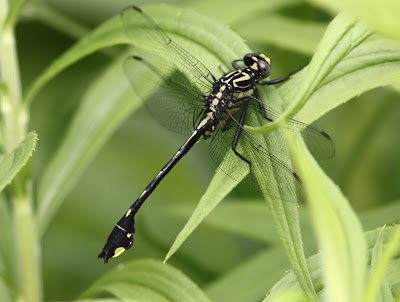Yesterday was calm and clear, so a walk out Rondeau's south beach was in order. There were very few migrant passerines along the way, but there were lots of shorebirds out south beach.
Shorebirds were of the common and expected type, but I was hoping for a Red Knot or two. Red Knots are difficult to come by anymore, unlike they were back in the 1990's. There is still hope, but one will have to look towards fall migration soon!
Ruddy Turnstones seemed to be the most common, along with Dunlin. This turnstone was keeping an eye to the sky.
Numerous gulls were out there, and four immature Little Gulls were the highlight.
Lots of Bonaparte's Gulls to sort through.
Good time for a Laughing Gull, but no dice so far. I missed that one last year as well.
Of course, I kept an eye out for mussels. Included was this Deertoe, bleached and worn as most are along here.
Speaking of mussels, recently I got a mention on iNaturalist about the range expansion of Lilliput. As readers of this blog may recall, earlier this spring I found a new site for them at Reid CA, then I found a couple more up at Ausable River Cut CA.
Here is the quote from Sam Taylor on iNaturalist:
Lilliput Range Expansion Through iNat
Whereas some of our river mussels are charismatic (to a mussel enthusiast) with large sizes, dramatic colours and patterns, and interesting textures, the Lilliput (Toxolasma parvum) may be about as drab and inconspicuous as they come.
It's a small mussel often not much larger than a thumb with a plain brown, cloth-like exterior. While most mussels prefer running water and a mix of sand, cobble, and gravel substrate, the Lilliput is perfectly content in warm muddy backwaters - and even excels there! Because of their unassuming appearance and preference for mucky habitats, they're often missed in conventional mussel surveys.
The difficulty in detecting this species has led to uncertainty about its population status, prompting its assessment as Endangered federally, and Threatened in Ontario. Currently, populations are known in Ontario in the following locations.
In Lake St. Clair Watersheds:
-Canard River
-Ruscom River
-Belle River
-Sydenham River
In Lake Erie Watersheds:
-Grand River
-Thames River (with new occurrences detected in 2022),
-Pelee Island
-Welland River
-Lake Erie proper
In Lake Ontario Watersheds:
-Hamilton Harbour
-Jordan Harbour
That said, in December of last year I was fortunate to find a tiny weathered valve of a Lilliput in Port Franks of the Ausable River. This would represent a significant range expansion into the Canadian side of Lake Huron! Though with only a single weathered valve there are always doubts.. could this be a one-off? is the identification correct? But then in April 2024, @burgbirder discovered two more Lilliput valves from the same location! This provided additional confidence in the first valve and seems to suggest there is indeed a population currently within the Ausable River. Although it's unknown if this population has been introduced (Lilliput are fantastic colonizers) or always present and just undetected, it certainly warrants future investigations into Lake Huron-draining watersheds.
Without iNat, this expansion certainly wouldn't have been possible. So big thanks to @burgirder and of course many thanks to everyone who has contributed to the Canaiad project thus far. Some may remember me reaching out in 2022 for information regarding Lilliput observations; the Canaiad project was happy to provide Fisheries and Oceans Canada (DFO) with Lilliput coordinates for the reassessment of the species currently underway. I look forward to seeing what other discoveries can be made.
In the future, I hope to write more journal posts highlighting interesting finds, and maybe bring some attention to previous ones as well.
Happy musseling,
Sam
Today, Saturday, we had some rain in the morning, so I did little birding.
This afternoon, I suddenly had the urge to check out Wardsville Woods.
Some good odonates are starting to show, and I was not disappointed.
Lots of Midland Clubtails were out and about.
Early on, I caught sight of an ode I was hoping for. A Cobra Clubtail, which is a rarity around here!
Next was a decent damsel which I have not seen many of, and certainly not one at Wardsville. This little Sedge Sprite caught my eye.
Around the back pond, some Double-striped Bluets were doing their thing. Another somewhat rare species.
Up the hill at the back, I saw another single.
There were several common odes as well, but this Four-spotted Skimmer was a first for me at Wardsville apparently.
I made several rounds in key areas, and was on my last pass when a familiar large dragon caught my eye. An Arrowhead Spiketail!
There may have been two, but this is another rarity in our parts. I discovered this species as well as Twin-spotted Spiketail at Wardsville a few years ago. First for Middlesex then, apparently.
Another interesting insect was this Green-legged Spur-throat Grasshopper. Not one I have noticed before, but it certainly has a catchy name.
A first-of-year Peck's Skipper was at the pond.
So, the day was not a washout afterall.




















No comments:
Post a Comment